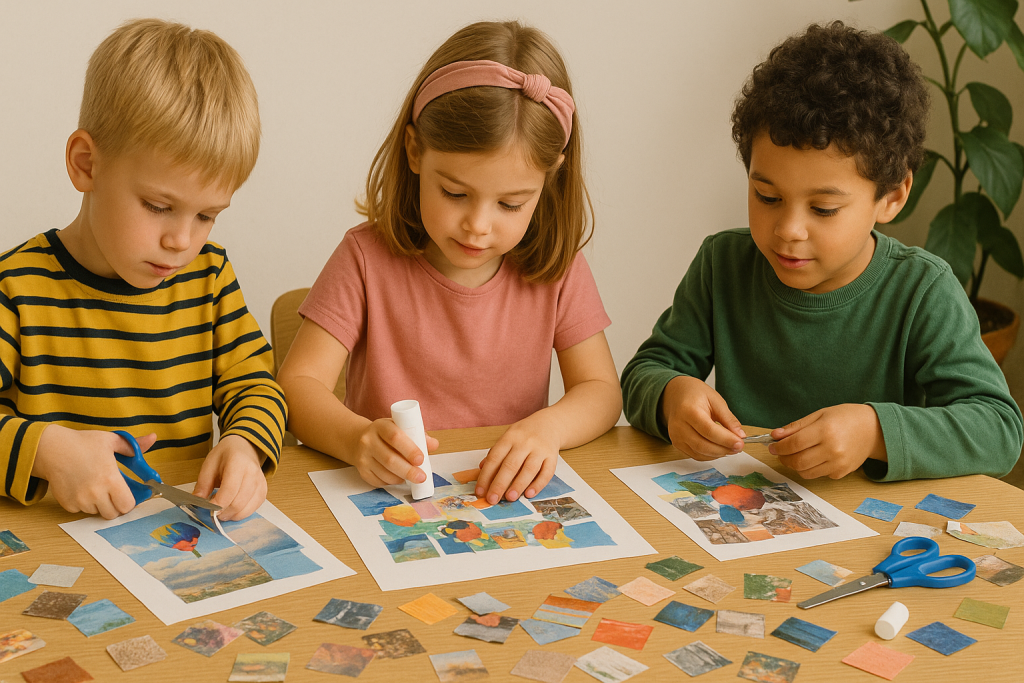Exploring the outdoors with kids is already an adventure, but turning those found treasures into art makes it even more memorable. A nature collage invites children to collect leaves, flowers, seeds and twigs on a walk and arrange them into a personal keepsake. The finished piece reflects the colours and textures of the season and gives families an excuse to slow down, look closely and appreciate their local environment.
Key Points:
A nature collage turns a simple outdoor walk into an art activity where kids collect leaves, petals and natural items to arrange into seasonal artwork. It supports creativity, observation skills and respect for nature. Display the finished collage as a framed piece or window suncatcher for a memorable keepsake.
Gather your materials on a nature walk
A successful collage starts with a good collection trip. Plan a short stroll around your neighbourhood park or even your own yard and encourage kids to pick up interesting fallen items. The Artful Parent suggests gathering petals, leaves, acorns and twigs and setting them out on a table with glue and scissors. Kids can also collect shells, driftwood or feathers as long as they do so responsibly. We agree with some sources that collecting only what you need and taking small amounts from each plant to avoid damaging habitats. Remind children not to uproot plants and to leave behind anything rare or protected. This is a great opportunity to talk about respect for nature and why we leave enough for wildlife and other people.
At home, clean and sort the items. Cardboard makes a sturdy base for a collage, but you can also use clear Con‑Tact paper for a “suncatcher” effect. We recommend taping the non‑sticky side of the Con‑Tact paper to the table, peeling off the backing and letting little hands arrange their finds directly onto the sticky sheet. For a mess‑free version on cardboard, stretch a few rubber bands around the board to hold leaves and petals in place.
Assemble your collage
Once the supplies are ready, invite children to play with patterns. There is no right or wrong way to design a nature collage; even toddlers can create something beautiful by layering leaves and flower petals. The Artful Parent encourages arranging pieces on the cardboard first and gluing them down only when the design feels right. When using Con‑Tact paper, pressing a second sheet on top seals everything in place and creates a translucent artwork that looks lovely taped to a window. Rubber bands make the collage temporary; kids can slide different leaves under the bands and change the design whenever inspiration strikes.
To extend the project, turn the collage into a landscape or pattern. Golden Road Arts points out that arranging leaves, twigs, feathers and pebbles on cardboard can represent a landscape or an abstract design. For a colourful background, mix paints inspired by the season—blues and yellows to create different shades of green in spring, or reds and oranges for autumn. You can even dip flowers in paint and make prints before adding them to the collage. These variations keep older children engaged and teach simple colour theory.
Display and preserve
When the artwork is complete, decide how to show it off. Frame cardboard collages and hang them in the kitchen or children’s bedrooms. If you’ve created a Con‑Tact paper suncatcher, tape it to a sunny window. Rubber‑band collages can live on a tabletop as a rotating nature display. Encourage kids to talk about where they found each item and why they placed it where they did. This conversation builds vocabulary and helps children develop storytelling skills.
More ideas and resources
Nature collages are just one way to turn outdoor adventures into art. For a larger project, try making a family collage on poster board; everyone can contribute photos and magazine clippings alongside natural objects. You might also explore leaf rubbing or pressed‑flower art as a follow‑on activity. To ensure sustainable crafting, read Birch & Button’s full guide on collecting natural objects.
Further reading and videos
- Step‑by‑step tutorial: The Artful Parent provides a detailed guide on making nature collages with children, including material lists and instructions.
- Contact‑paper collages: The Kids Activities Blog version uses clear Con‑Tact paper so even toddlers can stick petals and leaves to create a suncatcher.
- Seasonal art inspiration: Golden Road Arts offers ideas for spring‑themed art projects, encouraging kids to collect outdoor items and mix seasonal colours.
- Ethical foraging tips: Birch & Button’s guide shares dos and don’ts for collecting natural craft materials responsibly.

Related DIY Explorers posts
On Diy Explorers you’ll find many other projects that pair outdoor adventures with art. After making a nature collage, try our Career Day at Home With the Kids: DIY Edition for ideas on what to collect next, explore how to craft your own board game for more sustainable projects or learn how to create your own birdhouse. For a list of ideas to explore with little ones, see Creative Crafts & DIY Projects For the Whole Family.
Videos for inspiration
Are you more a visual learner? We love to include interactive and dynamic videos for you to see really what can happen when you put your mind (and your loved one’s) together !
- The Art of Nature For Kids – A Nature Collage
- Really great for starting out. Short and sweet video that will get you doing a collage in no time!
- 5 Nature collage ideas for kids
- If you just need ideas. This is a perfect video because it is quick and simple, showing you great ideas to get started.
Oh, do you wish to keep the collage as a special memento or create a new one each season? There is so many options (isn’t that why we love collages) this simple project turns outdoor exploration into lasting memories. It requires nothing more than a walk outside, a few art supplies and the willingness to see beauty in twigs, leaves and petals.
Quick FAQ
Children can collect fallen leaves, petals, twigs, seeds, feathers, shells and small natural items found on the ground. Always gather responsibly—avoid rare plants and never pick living or protected species.
Set out cardboard or clear Con-Tact paper and let kids arrange their found items freely. Toddlers can place pieces on sticky paper, while older children can plan patterns and glue items down. Keep the process simple, playful and mess-friendly.
Cardboard collages can be framed, hung in kids’ rooms or placed on a shelf. Con-Tact paper collages work beautifully as window suncatchers. Rubber-band collages can remain open-ended and be redesigned throughout the season.
